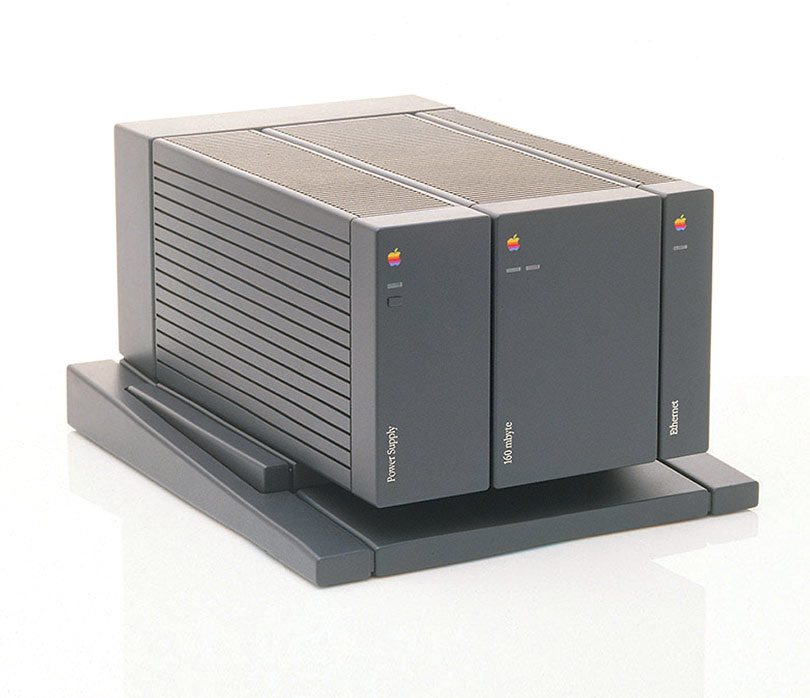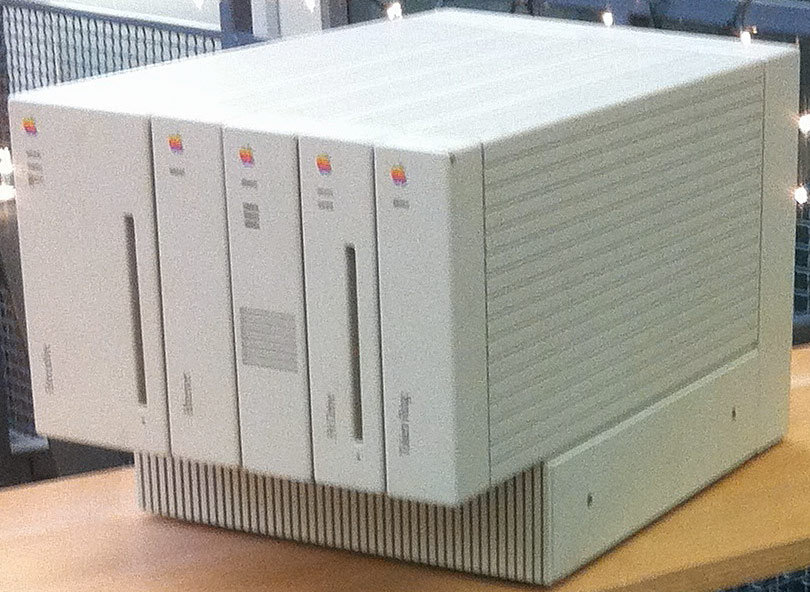In late 1984 the Macintosh’s Apple’s market share was just 15% and Steve Jobs, John Sculley and their staff were running various scenarios to gain sales without losing the much-needed profit to fund R&D and advertising.
According to designer Tony Guido the question at Apple was:
“What would it take to put the Mac on as many desktops as possible, without licensing, in a way that would convince DOS users to migrate toward the Mac?”
At the same time hardware engineer John Fitch, having just completed work on the IIgs, was worried by the lack of follow-up product for the Apple II. Fitch wanted to design a computer around a new chip, the Motorola 68030, which would be powerful enough for business and high-end applications, but could also be offered to home users.
Inspired by the Apple II “open” architecture mindset, Fitch proposed a modular approach.
He designed a simple hardware “backbone” carrying basic operations and I/O on which the user could add a series of “book” modules, carrying hardware for running Apple II, Mac, UNIX and DOS software, plus other modules with disk drives or networking capabilities.

Thus beginners, mid-level and high-end customers could all use the same basic hardware but could configure and enhance their systems over time.
Apple could manufacture at low cost and publish (or license) the specs to the “spine” and ensure wide acceptance. Most importantly, Jonathan could offer both Macintosh and DOS compatibility, giving PC users an opportunity to “cross over”, sample the Macintosh and stay with it, or use both on the same system.
Fitch named his concept “Jonathan” and asked Helmut Esslinger, Guido and the frogdesign team to help him design a physical model to present to management. Hesslinger was initially skeptical but later adopted and implemented the “books on a shelf” metaphor, understanding that, unlike conventional computers, Jonathan could look not only strikingly different but also more impressive as its performance increased.
After eight months of development, a Jonathan mockup was finally unveiled to the Apple Executive staff in June 1985.

The Executives’ first reaction was of astonishment. The design’s militaristic look with smooth surfaces, sharp corners, vertical ribs around the base and the use of a dramatic black color with white product graphics was unlike anything done before at Apple.
The Jonathan concept was deemed too advanced and risky. Jean-Louis Gassée, who at the time was Apple’s VP of Product Development, observed that they would have to sell two or three Jonathans to equal the profit of a single Macintosh II.
Also: Apple’s CEO John Sculley voiced the fear that Jonathan could be a trojan horse in reverse.

Once Mac and DOS were offered on the same platform, more Apple users might move to DOS than the other way around. That would spell trouble for the Macintosh, which was still looking to get a foothold in the market and would find its well deserved (and rewarded) niche only the following year, thanks to DeskTop Publishing.
June’s presentation spelled the end of the project, although not necessarily of the work done by engineers and designers. Apple later used Fitch’s work with the 68030 in the the Mac IIx and IIfx, and some key design elements of Jonathan, such as the ribbing and sharp corners, were incorporated by frogdesign in the first unified look of Macintosh products, known as SnowWhite.
Credits: the first two pictures are taken from “Design Forward”, published by ARNOLDSCHE Art Publishers, and copyright Hartmut Esslinger & frog(design) team. The last picture is by Dan Lieberman, released under a Creative Commons Attribution 2.0 Generic license and courtesy of Blake Patterson of The Byte Cellar.

mysterian
The 68030 was first used in the IIx. I have one that I bought new and it still works.
Nicola D'Agostino
mysteriam: the part about the 68030 is taken from “AppleDesign” and the authors don’t state that the IIfx was the first Mac to use the CPU, but that “[…] Apple later used Fitch’s work with the Motorola 68030 in a top-of-the-line Mac II, known as the Mac IIfx […]”
Châu
Fitch should open source designe before show any person, pressure Apple use it because other company can use it too.
Grant
This would have been a rather nice machine to have. But I can see that it would have taken some time to get off the ground and be a profitable product line, but a very cool idea.
I am really scratching my head tho as to why they thought someone who would want to have MacOS on this computer, think that DOS would be better for them and thus they would migrate to DOS instead.